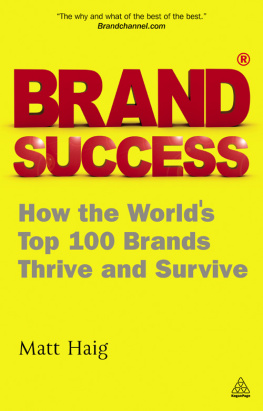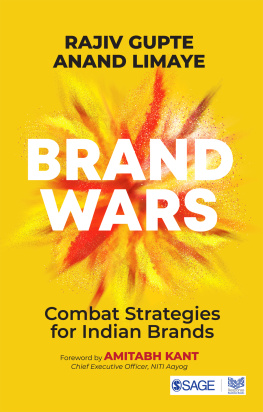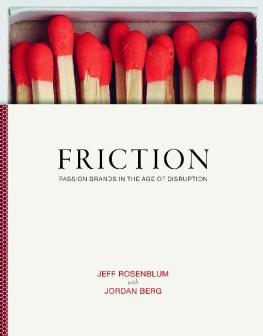INTRODUCTION
Oakley had a problem.
Over the previous decades, it had established itself as a titan in the world of eyewear thanks to its tenacious, take-no- prisoners culture. It was everything a brand aspires to be: it pushed the boundaries of the industry, setting the pace and letting its competitors try to play catch-up, all supported by a dedicated community of brand ambassadors who were only too happy to be part of the aspirational, active Oakley lifestyle.
But there was just one problem: their community went wild for their culture and design, but there were several related product categories that were going untapped. While Oakley eyewear was a study in breakthrough products that drove the market, the apparel, footwear and accessories (AFA) product line extensions were not part of the brands portfolio. The company was sure they could take on other action sports brands and build a successful business
where one did not exist today. Quiksilver and Billabong, among other action sports brands, were taking the lions share of those markets. Oakley said, We can do that, too!
A plan was put in place, and the categories were launched. The product teams were given the go-ahead to launch a whole new line of Oakley-branded AFA products. The eyewear division would keep doing what they were doing so well, and the AFA teams would get the resources needed to build the brand bigger than ever. In short order, Oakley was ready to begin a new chapter in their dominance of these new market opportunities.
And thats when Oakleys little problem became a much bigger problemone that would alienate some of their core community and drive the entire brand culture in a different direction. Both category authenticity and channel distribution would quickly become problems whereas they hadnt been before. Oakley began to lose its cultural direction, as well as those loyal brand ambassadors who stuck with the brand through its evolution over the decades. They had loved and embraced the brand for what it was, not what it was becoming.
In the end, Oakley was more fortunate than most brands that go down a similar roadtrying to be something they are not. After making the decision to dedicate themselves to creating what was right for the brand and aligning with their brand identity, they were able to regain their customers trust and brand equity, and were finally able to climb their way back to the top of their core product categories.
Most brands dont get a second chance like thatOakley was only able to manage it because the visionaries steering the brand had the courage to reflect on what had happened so they could learn from what did not work and get back to what did work doing what is right for the brand and their loyal customers.
Even global, iconic brands can end up losing sight of their cultural bloodlines if they are not committed to the foundational pillars on which their brands were built. No matter how solid the product, marketing, and salesno matter how powerful your formula for successwithout a singular guiding vision at the helm determining what is right for the brand, what will drive it forward into the next generation?
In other words, Oakley learned early on what it takes to be a truly visionary brand as opposed to one that loses its way.
BECOMING VISIONARY
Over my nearly three decades in business from founding my own company to successfully selling it to being involved in executive-level roles with some of the worlds most iconic brandsI have come across brands that have visionary qualities. But ultimately, none have had all that is required to achieve authentic visionary brand status. Somewhere in the brand, something is almost always missing. Even brands like Under Armour and Oakleyones that build themselves up to the top of their industrycan lose sight of their future when they abandon the principles that made them great in the first place. Ultimately, no
matter how strong a brand may be in a dozen different capacities, all things considered, it is an incredibly difficult task to achieve and sustain a visionary brand.
When asked about what makes a brand visionary , most people will come up with three or four common traits associated with a brand:
Product Marketing Culture Innovation
These are good starting points, but each on its own does not make for a visionary brand, nor do all four put together. To achieve visionary status, you must not only have these core qualities, but all must be built in as an integral part of your brands foundation. That foundation needs to be structurally upheld by foundational pillars that support your vision in every aspect of the brands actionsboth internally and with the world at large.
Throughout my years, I have always been curious as to what makes a genuinely visionary brand. There are qualities like the four mentioned above, but in reality, it takes the vertical integration of many different pieces to make a brand run on all cylinders effectively. You may have a Lamborghini that looks fast, but if you are only running on six cylinders, you are missing out on its full potential. And so it goes with brands; some are six cylinders, some eight . . . but I have yet to see one that runs on all twelve over the long haul.
Thats not to say becoming a visionary brand is impossible however, it is a continual struggle to establish and live up to the pillars your brand was founded on. Above all else, being visionary involves touching, impacting, and energizing all aspects of your companyall the bloodlines that flow through the veins of a living, breathing organ called a brand.
As the leader of a brand, youre essentially acting as an orchestra conductor: youre not just leading individuals with different talents in their independent tasks, but synthesizing their talents and efforts toward the singular goal of collectively making music as a unit. Depending on your actions and your vision, the result can be either harmonious or disastrous.
At the end of the day, it is your responsibility to ensure each player in the orchestra is correctly prepared, synchronized, and in harmony with one another. How you lead the ensemble can be translated to a brands eventual success. Where there is a common goal, along with preparation and coordination, beautiful things happen at all levels. Although challenging, having a shared visionled from the top down and anchored in guiding and values-driven principlesensures everyone involved will be committed to achieving success.
Or to employ another metaphor: I often refer to those visionaries who have been able to achieve this brand status as five-star generals. They are few in number, and each has successfully led their teams into battles and achieved many victories. Obviously, leading a brand is not the same as going to war, but this gives you some idea of the kind of difficulties you will encounter as
you move through the different stages of brand development. You will face choices that test your foundational, visionary principles, ones that will affect the future of your brand. As a result of your choices, your brand will continue to grow and develop . . . or it will deteriorate before the eyes of your team and your supporters. Understanding the growth of a brand is a trait not easily discovered, which is why so few true visionaries exist. I have found that brands that have sustained growthnot just revenue, but also brand equitytend to have this trait in common. Brands that have nurtured the soul of their company are the ones that provide value in the eyes of the consumer. This value may be realized through the products a brand sells, and likewise through the brands culture or the aspirational lifestyle they market to their community. Each delivers a different loyalty curve or experience









